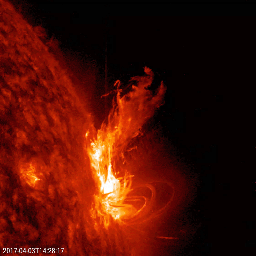(to view a video of the flare above visit https://photojournal.jpl.nasa.gov/catalog/PIA21584 )
by Justin Kerr
With the search for habitable exoplanets well underway, there has been much talk in popular science of the potential to find life-bearing worlds with telescopes such as Kepler and TESS. One of the most common points I have heard in the popular sphere against finding life with these missions is related to stellar flares. The argument is typically as follows: the transit method used to detect exoplanets with these telescopes mostly finds small stars (of spectral type M, to be specific); these M stars and particularly red dwarfs such as TRAPPIST-1 tend to produce frequent stellar flares; therefore the flares will cause planets to be incapable of maintaining an ozone layer and the life which depends on such a layer. While this is certainly true to some extent, it is not the case that all red dwarfs produce frequent flares – and in some cases, stellar flares may even be required for their exoplanets to support life as we know it. In either extreme case, it is clear that an understanding of the possible effects of stellar flares and their frequency is important when evaluating the possibility of life existing on newly discovered exoplanets.
First of all, are these popular accounts correct about stellar flares making life impossible? The most well-known consequence of stellar flares is their tendency to be accompanied by a Coronal Mass Ejection (CME), something that happens right here in our solar system. In a CME, plasma from the star is launched outwards by strong magnetic fields. The Carrington Event in 1859 was a CME associated with a solar flare which, while not strong enough to cause any atmospheric disturbances beyond intense auroras, did result in massive disturbances to the telegraph systems used at the time. A similar event in modern times would cause extensive problems in our electrical systems, but much stronger events must be considered for highly active red dwarf stars. Not only are these stars more active, but potentially habitable planets must be located much closer to the star than is the case with the Sun in order to receive enough heat to maintain liquid water. This makes them more likely to be hit by strong CMEs, as CMEs release their energy in a narrow and directed region. The main threat of highly energetic CMEs to habitability is their capability to “blow off” the atmosphere of an exoplanet over multiple events, similar in function to a very strong solar wind.
While CMEs are commonly discussed due to their threat to our modern technology here on Earth, the removal of the ozone layer by stellar protons from flares is much more concerning for exoplanets around small stars. Studies such as Tilley et al. (2019) have shown that flares with energies of about two orders of magnitude stronger than the Carrington event that occur once a month or more would be enough to make an exoplanet incapable of maintaining an ozone layer. This would lead to the sterilization of the exoplanet’s surface by the excess UV radiation, in an extreme version of the ozone layer hole on Earth which is only now beginning to recover after the Montreal Protocol stopped the widespread use of CFCs. A recent study by Günther et al. (2020) that examined 1228 flaring stars found in the first exoplanet hunting dataset released by TESS found that about 100 of the stars would meet the flare frequency requirements to eliminate the possibility of an ozone layer on their associated exoplanets. While this is certainly a concern, this still leaves a large amount of red dwarf associated exoplanets presumably without this problem.
These negative aspects of stellar flares are not the only way in which flares can affect exoplanets. There are in fact multiple ways that flares may instead support or even be required for the development of life. Since red dwarfs have low UV output, some exoplanets within the habitable zone may not receive enough UV light to support the prebiotic chemistry that life as we know it is based on. Of particular interest is the reaction that produces the RNA, which is required by life, as it only occurs in the presence of UV light. Since stellar flares can produce extra UV light, they could fill in the missing energy to allow prebiotic chemistry to occur around stars where it would otherwise be impossible. In the same study of flaring stars from TESS, Günther et al. found 14 stars where this may possibly be the case. While this is less than the amount of exoplanets where flares would make life impossible, ignoring the positive benefit of flares could cause us to miss habitable exoplanet candidates.
Stellar flares are certainly a danger to the habitability of exoplanets around red dwarfs, but we have seen that this by no means eliminates the possibility of life on all them and in some cases may even be necessary. Instead of dismissing flares as a negative, we must instead study their effects and frequency in order to better predict where we might find new life. So the next time you hear a YouTube video or see an online comment suggest that life around red dwarfs is impossible thanks to flares sterilizing them, make sure to do a bit more research!
Sources:
Günther et al. (https://doi.org/10.3847/1538-3881/ab5d3a),
Tilley et al.
(http://doi.org/10.1089/ast.2017.1794)

No comments:
Post a Comment